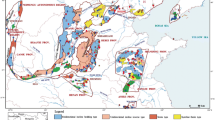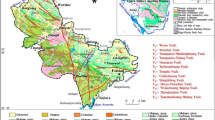Abstract
Approximately 3.44 million km2 of carbonate rock exists in China and occupies one-third of China’s territory. In general, the karst in China can be classified as two types (i.e., the karst in north China and the karst in south China) based on the paleodepositing environment of carbonate rocks and subsequent karstification processes. On the one hand, the lithology of carbonate rocks deposited between the Mesoproterozoic Era and the Mid-Ordovician in north China are micritic, which is difficult to erode compared with the sparry limestones common to south China, and deposited between the Sinian Sub-Era and the Triassic period. On the other hand, the paleoclimate during karstification processes in north China was dry and cold, and karstification occurred mainly in the subsurface, whereas the paleoclimate during karstification in south China was wet and warm, and karstification took place mostly at or near the surface. Karst aquifers are therefore characterized by fractures and conduits in the north, and by caves, tunnels, and subsurface rivers in the south. One of the significant characteristics of a karst hydrological system in the north is that the groundwater in a karst aquifer converges in a topographical depression and creates a large karst spring. To better understand the effects of climate variation and anthropogenic activity on spring discharge, the authors focused on the karst hydrological processes in north China, examined the Niangziguan Springs as a case study of karst hydrology in north China, and analyzed the spring discharge from 1959 to 2015 using statistical methods, including piecewise analysis, Wilcoxon rank-sum test, and wavelet coherence. Results indicate that the data of the Niangziguan Springs discharge can be divided into two groups: a pre-development period from 1957 to 1980 and a post-development period from 1981 to 2015. The annual average precipitation was 531 mm in the pre-development period and 462 mm in the post-development, showing a 13% decrease in precipitation. The annual mean spring discharges in the pre- and the post-development periods were 12.54 and 7.67 m3/s, respectively, showing a 39% decline. Compared to the precipitation, the spring discharge has a 26% greater reduction on average between the periods. This fact indicates that the spring discharge was attenuated by almost 26% owing to the effects of human activity in the Niangziguan Springs basin. To see whether human activity alters the frequency (i.e., short- and long-term variations) of the discharge of Niangziguan Springs, the time series of spring discharge in both the pre- and the post-development periods were analyzed by wavelet coherence. Results indicate that although groundwater development has weakened the relation between spring discharge and precipitation, the resonant frequency between spring discharge and precipitation remain unchanged.
Access this chapter
Tax calculation will be finalised at checkout
Purchases are for personal use only
Similar content being viewed by others
References
Asmita RM, Dhyan SA (2014) Trend and periodicity analysis in rainfall pattern of Nira Basin, Central India. American Journal of Climate Change 3(1): 60–70
Cai Y (1997) Ecological and socio-economic rehabilitation in the karst of the southwest China. The Journal of Chinese Geography 7: 24–32 (in Chinese)
Charlier J, Ladouche B, Maréchal J (2015) Identifying the impact of climate and anthropic pressures on karst aquifers using wavelet analysis. Journal of Hydrology 523: 610–623
Fiorillo F, Petitta M, Preziosi E, Rusi S, Esposito L, Tallini, M (2015) Long-term trend and fluctuations of karst spring discharge in a Mediterranean area (central-southern Italy). Environmental Earth Science 74(1):153–172
Grinsted A, Moore JC, Jevrejeva S (2004) Application of the cross wavelet transform and wavelet coherence to geophysical time series. Nonlinear Process Geophysics 11 (5/6):561–566
Gu H (1995) The Carboniferous to Jurassic bauxite deposits are symbols of paleoclimate and palaeogeography. Light Metals 6: 1–5 (in Chinese)
Guo Q, Wang Y, Ma T, Li L (2005) Variation of karst springs discharge in recent five decades as an indicator of global climate change: a case study at Shanxi, northern China. Science in China Series D: Earth Science 48: 2001–2010
Han B (1998) Study of microkarstification mechanism. Geological Publication House, Beijing, pp. 26–30 (in Chinese)
Han X, Lu R, Li Q (1993) Karst Water Systems: A Study on Big Karst Spring in Shanxi. Geological Publishing House: Beijing (in Chinese)
Hao Y, Cao B, Zhang P, Wang Q, Li Z, Yeh T (2012) Differences in karst processes between northern and southern China. Carbonates and Evaporites 27: 331–342, doi:101007/s13146-012-0116-3
Hao Y, Cao B, Chen X, Yin J, Sun R, Yeh T (2013) A piecewise grey system model for study the effects of anthropogenic activities on karst hydrological processes. Water Resources Management 27(5): 1207–1220
Hao Y, Zhang J, Wang J, Li R, Hao P, Zhan H (2016) How does the anthropogenic activity affect the spring discharge? Journal of Hydrology 540: 1053–1065
He Y, Han B, Xue C, He Y (1997) Study of karstic water in China. Tongji University Press, Shanghai (in Chinese)
Helsel DR, Hirsch RM (2002) Studies in Environmental Science 49: Statistical Methods in Water Resources. Elsevier Science Publisher Company INC: New York
Hudson DJ (1966) Fitting segmented curves whose join points have to be estimated. Journal of American Statistical Association 61: 1097–1129
Li D (1985) Explanation of the map of soluble rock type in China. Cartographic Publication House, Beijing, pp 29–35 (in Chinese)
Liang Y, Gao H, Zhang J, Huo J, Wang T (2005) Preliminary quantitative analysis on the causes of discharge attenuation in Niangziguan spring. Carsologica Sinica 24(3): 227–231 (in Chinese)
Liang Y, Han X, Xue F (2008) Water resources conservation for karst spring basin of Shanxi Province. China Water and Power Press: Beijing (in Chinese)
Miao J, Liu G, Cao B, Hao Y, Chen Yeh TJ (2014) Identification of strong karst groundwater runoff belt by cross wavelet transform. Water Resources Management 28: 2903–2916
Quandt RE (1958) The estimation of the parameter of a linear regression system obeying two separate regimes. Journal of American Statistical Association 53:873–880
Ramos JI (2005) A piecewise-analytical method for singularly perturbed parabolic problems. Applied Mathematics Computation 161:501–512
Sun Z (2006) The mechanism of Niangziguan Springs decline and conservation measures. Shanxi Water Resources 22(1): 16–17 (in Chinese)
Sweeting MM (1995) Karst in China, its geomorphology and environment. Springer Inc., New York
Torrence C, Compo GP (1998) A practical guide to wavelet analysis. Bulletin of the American Meteorological Society 79 (1):61–78
White W (1988) Geomorphology and hydrology of karst terrain. Oxford University Press, New York
Wilcoxon F (1945) Individual comparisons by ranking methods. Biometrics Bulletin 1(6): 80–83. https://doi.org/10.2307/3001968
Yuan D (1993) The karst study of China. Geology Press, Beijing (in Chinese)
Yuan D (1994) Karstology of China. Beijing: Geological Publishing House; (in Chinese)
Yuan D, Li B, Liu Z (1995) Karst in China. Episodes 18 (1–2): 62–65
Zhang H, Guo Y, Miu P, Sun K (2014) Analysis on the status of water ecological investigation in Niangziguan spring area and the cause of spring discharge attenuation. China Environmental Science Society academic essays (in Chinese)
Zhang J (2004) Variation of mechanical property of marlite in process of karstification and weathering in three gorges region. Chinese Journal of Rock Mechanics and Engineering 23: 1073–1077 (in Chinese)
Zhang J, Hao Y, Hu BX, Huo X, Hao P, Liu Z (2017) The effects of monsoons and climate teleconnections on the Niangziguan Karst Spring discharge in North China. Climate Dynamics 48(1): 53–70
Zhang K, Luo Z, Zhang Q, Yao H (1981) The evolution of continent plate of China and the basin rich in petroleum and gas. Petroleum Exploration and Development 1:13–25 (in Chinese)
Zhang Z (1980) Karst types in China. GeoJournal 4(6): 541–570
Acknowledgements
This work is partially supported by the National Natural Science Foundation of China 41272245, 40972165, and 40572150, and Natural Science Foundation of Tianjin, China (18JCZDJC39500). The authors sincerely thank three anonymous reviewers for their detailed and constructive comments to improve this manuscript.
Author information
Authors and Affiliations
Corresponding author
Editor information
Editors and Affiliations
Rights and permissions
Copyright information
© 2020 Springer Nature Switzerland AG
About this paper
Cite this paper
Hao, Y., Zhang, J., Guo, Y. (2020). The Characteristics of Karst Aquifers and the Variation of Karst Hydrological Processes in Northern China. In: Bertrand, C., Denimal, S., Steinmann, M., Renard, P. (eds) Eurokarst 2018, Besançon. Advances in Karst Science. Springer, Cham. https://doi.org/10.1007/978-3-030-14015-1_19
Download citation
DOI: https://doi.org/10.1007/978-3-030-14015-1_19
Published:
Publisher Name: Springer, Cham
Print ISBN: 978-3-030-14014-4
Online ISBN: 978-3-030-14015-1
eBook Packages: Earth and Environmental ScienceEarth and Environmental Science (R0)




